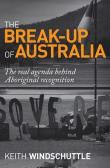
Latest Issues
AbstractHistoryArchive Description
'Australian voters are not being told the truth about the proposal for constitutional recognition of indigenous people. The goal of Aboriginal political activists today is to gain ‘sovereignty’ and create a black state, equivalent to the existing states. Its territory, comprising all land defined as native title, will soon amount to more than 60 per cent of the whole Australian continent. Constitutional recognition, if passed, would be its ‘launching pad’. Recognition will not make our nation complete; it will divide us permanently.' (Publication summary)
Publication Details of Only Known VersionEarliest 2 Known Versions of
Works about this Work
-
Reconciliation, a Postcolonial Settlement and the Constitutional Recognition Debates : A Review Essay
2017
single work
essay
— Appears in: Transnational Literature , May vol. 9 no. 2 2017; 'In 2017, with a Parliament that features the newly-elected Senator Pauline Hanson, flanked by a handful of One Nation members, Australia seems to be entering a new Culture Wars. Senator Hanson’s 2016 maiden speech, much criticised for its scapegoating of Muslim Australians, revisited old ground. Indeed, much of the criticism remarked upon the fact that she seemed to have simply inserted ‘Muslim Australians’ in place of the ‘Asians’ or ‘Aboriginal Australians’ who were represented as the ‘problem’ for Australia back in 1996, when the Culture Wars polarised the nation. The Culture Wars 1.0 were characterised by an over-reaction to the Mabo decision of 1992, which polarised the nation by recognising that Native Title was not extinguished by white settlement, and that Terra Nullius was a ‘legal fiction’. The newly recognised rights of Indigenous Australians to their lands resulted in concerted opposition by powerful mining and pastoral lobbies, who argued that the Mabo decision diluted their rights to exploit Australian land. The Howard Government joined in, falsely claiming that Native Title legislation would threaten family homes. When the High Court found in the Wik case of 1996 that pastoral leases were not extinguished by Native Title, but could ‘co-exist’, the Government seized on the decision to find ways to extinguish Native Title. Howard’s Wik 10-point plan inserted a ‘national interest’ provision over Crown lands, and restricted both the time limits for claims to be lodged, and the types of lands that could be claimed. Mining and pastoral interests were reframed as ‘national’ interests’ , while Indigenous claims to territory were diluted, with Indigenous Land Use agreements effectively extinguishing Native Title when Indigenous and non-Indigenous parties reached an agreement. However, compensatory royalties would be provided to Indigenous traditional owners in exchange for mining or other commercial activities on their lands. In its dominant usage, ‘settlement’ in the Australian context implies the peaceable takeover of Indigenous territories in the name of the British Empire since 1788, with resultant waves of British immigration leading to the production of ‘Australia’ as a nation-state in 1901. These debates demonstrated that it was land – white possession and ownership – that was at stake throughout the following decade in an increasingly divisive debate about the politics of Reconciliation.' (Introduction) -
The Fabrication of Aboriginal Voting
2016
single work
essay
— Appears in: Inside Story , December 2016;'Keith Windschuttle has assembled a highly selective case against recognition of Indigenous Australians in the Constitution' (Introduction)
-
Reconciliation, a Postcolonial Settlement and the Constitutional Recognition Debates : A Review Essay
2017
single work
essay
— Appears in: Transnational Literature , May vol. 9 no. 2 2017; 'In 2017, with a Parliament that features the newly-elected Senator Pauline Hanson, flanked by a handful of One Nation members, Australia seems to be entering a new Culture Wars. Senator Hanson’s 2016 maiden speech, much criticised for its scapegoating of Muslim Australians, revisited old ground. Indeed, much of the criticism remarked upon the fact that she seemed to have simply inserted ‘Muslim Australians’ in place of the ‘Asians’ or ‘Aboriginal Australians’ who were represented as the ‘problem’ for Australia back in 1996, when the Culture Wars polarised the nation. The Culture Wars 1.0 were characterised by an over-reaction to the Mabo decision of 1992, which polarised the nation by recognising that Native Title was not extinguished by white settlement, and that Terra Nullius was a ‘legal fiction’. The newly recognised rights of Indigenous Australians to their lands resulted in concerted opposition by powerful mining and pastoral lobbies, who argued that the Mabo decision diluted their rights to exploit Australian land. The Howard Government joined in, falsely claiming that Native Title legislation would threaten family homes. When the High Court found in the Wik case of 1996 that pastoral leases were not extinguished by Native Title, but could ‘co-exist’, the Government seized on the decision to find ways to extinguish Native Title. Howard’s Wik 10-point plan inserted a ‘national interest’ provision over Crown lands, and restricted both the time limits for claims to be lodged, and the types of lands that could be claimed. Mining and pastoral interests were reframed as ‘national’ interests’ , while Indigenous claims to territory were diluted, with Indigenous Land Use agreements effectively extinguishing Native Title when Indigenous and non-Indigenous parties reached an agreement. However, compensatory royalties would be provided to Indigenous traditional owners in exchange for mining or other commercial activities on their lands. In its dominant usage, ‘settlement’ in the Australian context implies the peaceable takeover of Indigenous territories in the name of the British Empire since 1788, with resultant waves of British immigration leading to the production of ‘Australia’ as a nation-state in 1901. These debates demonstrated that it was land – white possession and ownership – that was at stake throughout the following decade in an increasingly divisive debate about the politics of Reconciliation.' (Introduction) -
The Fabrication of Aboriginal Voting
2016
single work
essay
— Appears in: Inside Story , December 2016;'Keith Windschuttle has assembled a highly selective case against recognition of Indigenous Australians in the Constitution' (Introduction)



